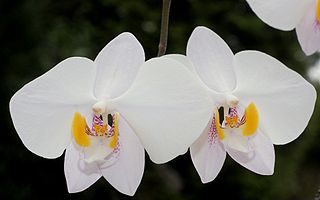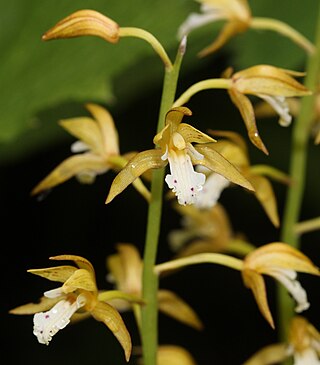Paphinia hirtzii is a species of orchid endemic to Ecuador.

Epidendrum blepharistes is a species of orchid in the genus Epidendrum native to Bolivia, Colombia, Costa Rica, Ecuador, Peru, and Venezuela.
Epidendrum polystachyumHBK (1816) is an epiphytic orchid, which grows wild in seasonally dry forests on the western slopes of the Andes in Ecuador and Peru at altitudes near 2 km.

Cattleya maxima is a species of orchid in subfamily Epidendroideae found from Ecuador to Peru.

Coelogyne fimbriata is a species of orchid.

Coelogyne flaccida is a species of orchid that is native to southeast Asia and northeastern South Asia. Cultivated as an ornamental plant, it is also known as the bearded coelogyne and the loose coelogyne.

Phalaenopsis philippinensis is an endemic species of orchid found from Luzon island in the Philippines.
Bulbophyllum xanthornis is a species of orchid in the genus Bulbophyllum.
Epidendrum parviflorum is a small-flowered reed-stemmed Epidendrum orchid found in the montane tropical wet forests of Bolivia, Ecuador, and Amazonas, Peru.

Epidendrum coronatum is a reed-stemmed epiphytic Epidendrum orchid that grows wild in the Neotropics at medium to low altitudes.
Epidendrum tridens is a terrestrial orchid closely allied to E. nocturnum, of which it has often been considered a variety or synonym. For example, Reichenbach 1861 lists Epidendrum tridens(Poepp. & Endl.) Cogn. (1898) as a synonym of Epidendrum nocturnum and Epidendrum nocturnum var. latifoliumLindl. (1837) as a distinguishable variety of Epidendrum nocturnum.
Epidendrum lanipes is an epiphytic sympodial orchid with spindle-shaped stems native to the montane tropical rainforest of Bolivia, Colombia, Ecuador, and Peru at altitudes ranging from 0.8 to 1.4 km.

Epidendrum sophronitisLinden & Rchb.f. (1857) is a small Epidendrum orchid that bears a superficial resemblance to a Sophronitis, as the generic epithet was used prior to the year 2000.
Epidendrum alpicola is a tropical orchid native to Bolivia, Colombia, Ecuador, Peru, and Venezuela at altitudes from 1.8—2.7 km.
Epidendrum adenoglossum is an orchid known primarily from its type herbarium specimen, Mathews 1073, collected in Peru near Pangoa. When Lindley published the name, he placed the species in the subgenus E. subg. SpathiumLindl. (1841). In 2005, Hágsater & Soto designated this species as the lectotype of E. subg. SpathiumLindl. (1841).

Epidendrum coriifolium is a sympodial orchid which grows both terrestrially and epiphytically at altitudes of 1.4—1.7 km in dense forests in Brazil, Ecuador, Mexico, Central America, and Venezuela.

Psychopsiella is a monotypic genus in the orchid family found only in the state of Rio de Janeiro in Brazil and near Caracas in Venezuela. It grows as an epiphyte in evergreen montane forests at elevations of 800 to 1,500 metres.

Oreorchis patens, the common oreorchis or 山兰 , is a species of orchid native to eastern Asia. It is known from Japan, Korea, the Russian Far East, and China. The common oreorchis is a terrestrial orchid with a sympodial habit of growth; it flowers on an inflorescence bearing yellow blooms.
Pachystoma nutans, is a species of plant in the orchid family. It is endemic to Myanmar. It was first described by Sing Chi Chen and Yi Bo Luo in 2002. The type specimen of Pachystoma nutans was previously overlooked among unidentified Eulophia species at the Royal Botanic Garden herbarium in Edinburgh. It is only known from the type specimen, which was collected near Mong Yaw, Myanmar.

Lepanthes kokonuko is a species of orchid from southern Colombia. L. kokonuko can be easily recognized by its caespitose medium-sized plants, elliptical coriaceous leaves, long loosely, flexuous and distichous inflorescences; strongly revolute lateral sepals, transversely bilobed petals with the upper lobe lanceolate (hornlike), and a bilaminate lip with the blades ovoid–lanceolate with a bipartite appendix.










